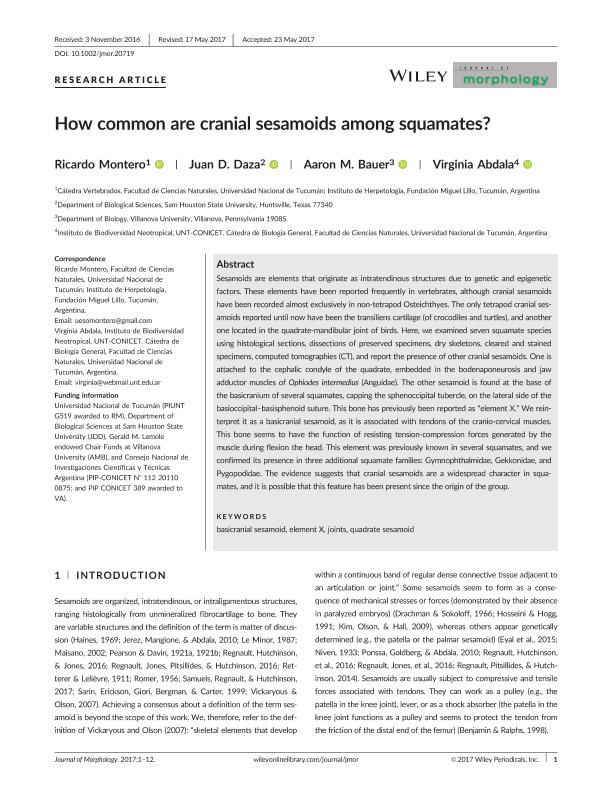Mostrar el registro sencillo del ítem
dc.contributor.author
Montero, Ricardo

dc.contributor.author
Daza, Juan D.
dc.contributor.author
Bauer, Aaron M.
dc.contributor.author
Abdala, Virginia Sara Luz

dc.date.available
2018-11-26T20:06:33Z
dc.date.issued
2017-10
dc.identifier.citation
Montero, Ricardo; Daza, Juan D.; Bauer, Aaron M.; Abdala, Virginia Sara Luz; How common are cranial sesamoids among squamates?; Wiley-liss, Div John Wiley & Sons Inc; Journal of Morphology; 278; 10; 10-2017; 1400-1411
dc.identifier.issn
0362-2525
dc.identifier.uri
http://hdl.handle.net/11336/65217
dc.description.abstract
Sesamoids are elements that originate as intratendinous structures due to genetic and epigenetic factors. These elements have been reported frequently in vertebrates, although cranial sesamoids have been recorded almost exclusively in non-tetrapod Osteichthyes. The only tetrapod cranial sesamoids reported until now have been the transiliens cartilage (of crocodiles and turtles), and another one located in the quadrate-mandibular joint of birds. Here, we examined seven squamate species using histological sections, dissections of preserved specimens, dry skeletons, cleared and stained specimens, computed tomographies (CT), and report the presence of other cranial sesamoids. One is attached to the cephalic condyle of the quadrate, embedded in the bodenaponeurosis and jaw adductor muscles of Ophiodes intermedius (Anguidae). The other sesamoid is found at the base of the basicranium of several squamates, capping the sphenoccipital tubercle, on the lateral side of the basioccipital–basisphenoid suture. This bone has previously been reported as “element X.” We reinterpret it as a basicranial sesamoid, as it is associated with tendons of the cranio-cervical muscles. This bone seems to have the function of resisting tension-compression forces generated by the muscle during flexion the head. This element was previously known in several squamates, and we confirmed its presence in three additional squamate families: Gymnophthalmidae, Gekkonidae, and Pygopodidae. The evidence suggests that cranial sesamoids are a widespread character in squamates, and it is possible that this feature has been present since the origin of the group.
dc.format
application/pdf
dc.language.iso
eng
dc.publisher
Wiley-liss, Div John Wiley & Sons Inc

dc.rights
info:eu-repo/semantics/openAccess
dc.rights.uri
https://creativecommons.org/licenses/by-nc-sa/2.5/ar/
dc.subject
Basicranial Sesamoid
dc.subject
Element X
dc.subject
Joints
dc.subject
Quadrate Sesamoid
dc.subject.classification
Otras Ciencias Biológicas

dc.subject.classification
Ciencias Biológicas

dc.subject.classification
CIENCIAS NATURALES Y EXACTAS

dc.title
How common are cranial sesamoids among squamates?
dc.type
info:eu-repo/semantics/article
dc.type
info:ar-repo/semantics/artículo
dc.type
info:eu-repo/semantics/publishedVersion
dc.date.updated
2018-10-23T17:55:41Z
dc.journal.volume
278
dc.journal.number
10
dc.journal.pagination
1400-1411
dc.journal.pais
Estados Unidos

dc.journal.ciudad
Hoboken
dc.description.fil
Fil: Montero, Ricardo. Fundación Miguel Lillo. Dirección de Zoología. Instituto de Herpetología; Argentina. Consejo Nacional de Investigaciones Científicas y Técnicas; Argentina
dc.description.fil
Fil: Daza, Juan D.. Sam Houston State Universitye; Estados Unidos
dc.description.fil
Fil: Bauer, Aaron M.. Villanova University; Estados Unidos
dc.description.fil
Fil: Abdala, Virginia Sara Luz. Consejo Nacional de Investigaciones Científicas y Técnicas. Centro Científico Tecnológico Conicet - Tucuman. Instituto de Biodiversidad Neotropical. Universidad Nacional de Tucuman. Facultad de Ciencias Naturales e Instituto Miguel Lillo. Instituto de Biodiversidad Neotropical. Instituto de Biodiversidad Neotropical; Argentina
dc.journal.title
Journal of Morphology

dc.relation.alternativeid
info:eu-repo/semantics/altIdentifier/doi/http://dx.doi.org/10.1002/jmor.20719
dc.relation.alternativeid
info:eu-repo/semantics/altIdentifier/url/https://onlinelibrary.wiley.com/doi/abs/10.1002/jmor.20719
Archivos asociados
